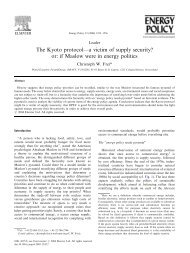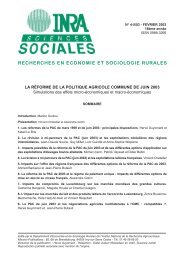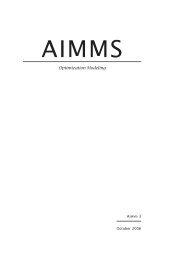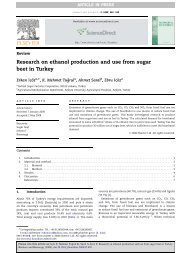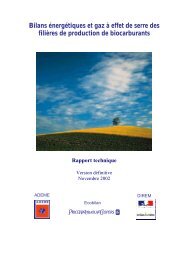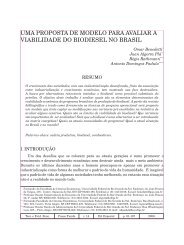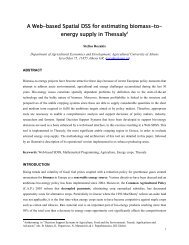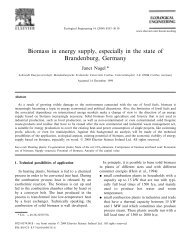Understanding entrepreneurial intentions of students in agriculture ...
Understanding entrepreneurial intentions of students in agriculture ...
Understanding entrepreneurial intentions of students in agriculture ...
You also want an ePaper? Increase the reach of your titles
YUMPU automatically turns print PDFs into web optimized ePapers that Google loves.
people <strong>in</strong> our measure <strong>of</strong> SN were close family, friends, and fellow <strong>students</strong>. SN reflects theperceived social pressure to start a firm.We believe this negative relationship between SN andINT largely echoes the current socioeconomic situation <strong>in</strong> Greece, where large sectors <strong>of</strong> theGreek population are <strong>in</strong> a state <strong>of</strong> poverty, s<strong>in</strong>ce they are not only <strong>in</strong> desperate need <strong>of</strong> the mostbasic facilities <strong>of</strong> a household but earn annually less than 60% <strong>of</strong> the median annual <strong>in</strong>come <strong>of</strong>a Greek citizen. Thus, results suggest that dur<strong>in</strong>g the Greek f<strong>in</strong>ancial crisis reference peoplehave no role to play <strong>in</strong> <strong>students</strong>’ decision to start a bus<strong>in</strong>ess. It is important to know thatparticipants had already demonstrated their <strong>in</strong>terest <strong>in</strong> entrepreneurship by choos<strong>in</strong>g theelective course on Strategic Management, <strong>in</strong> other words they are already positively biased or<strong>in</strong>terested. This could expla<strong>in</strong> some results, for <strong>in</strong>stance the remarkably high predictivecapacity <strong>of</strong> the model.Furthermore, it would be <strong>in</strong>terest<strong>in</strong>g to expand the survey group to lay <strong>students</strong>. Also theanalysis could be enriched us<strong>in</strong>g dummy variable <strong>in</strong> order to dist<strong>in</strong>guish between agriculturaldiscipl<strong>in</strong>es oriented to technical matters (crop, animal and food science and biotechnology) andagricultural economics <strong>students</strong> that counts for about half the sample population. Last but notleast two sub-groups based on <strong>entrepreneurial</strong> <strong>in</strong>fluence with<strong>in</strong> the close family could lead toclarify some f<strong>in</strong>d<strong>in</strong>gs <strong>of</strong> the analysis.6. REFERENCESAjzen, I. (1991). The theory <strong>of</strong> planned behavior. Organizational Behavior and HumanDecision Processes, 50, 179-211.Armitage, C. J., & Conner, M. (2001). Efficacy <strong>of</strong> the theory <strong>of</strong> planned behaviour: A metaanalyticreview. British Journal <strong>of</strong> Social Psychology, 40(4), 471-499.Bandura, A. (2001). Social cognitive theory: an agentic perspective. Annual Review <strong>of</strong>Psychology, 52, 1-26.Baron, R. A. (2008). The role <strong>of</strong> affect <strong>in</strong> the <strong>entrepreneurial</strong> process. Academy <strong>of</strong> ManagementReview, 32(2), 328-340.Baumgartner, H., Pieters, R., & Bagozzi, R. P. (2008). Future-oriented emotions:Conceptualization and behavioral effects. European Journal <strong>of</strong> Social Psychology,38(4), 685-696.Carter, N. M., Gartner, W. B., & Reynolds, P. D. (1996). Explor<strong>in</strong>g start-up event sequences.Journal <strong>of</strong> Bus<strong>in</strong>ess Ventur<strong>in</strong>g, 11(3), 151-166.Conner, M., & Armitage, C. J. (1998). Extend<strong>in</strong>g the theory <strong>of</strong> planned behavior: A review andavenues for further research. Journal <strong>of</strong> Applied Social Psychology, 28(15), 1429-1464.Knudson, W., Wysocki, A., Champagne, A., & Peterson, H. C. (2004). Entrepreneurship and<strong>in</strong>novation <strong>in</strong> the agri-food system. American Journal <strong>of</strong> Agricultural Economics,, 86,1330-1338.Krueger, N. F. J., Reilly, M. D., & Carsrud, A. L. (2000). Compet<strong>in</strong>g models <strong>of</strong> <strong>entrepreneurial</strong><strong>in</strong>tention. Journal <strong>of</strong> Bus<strong>in</strong>ess Ventur<strong>in</strong>g, 15, 411-432.8



